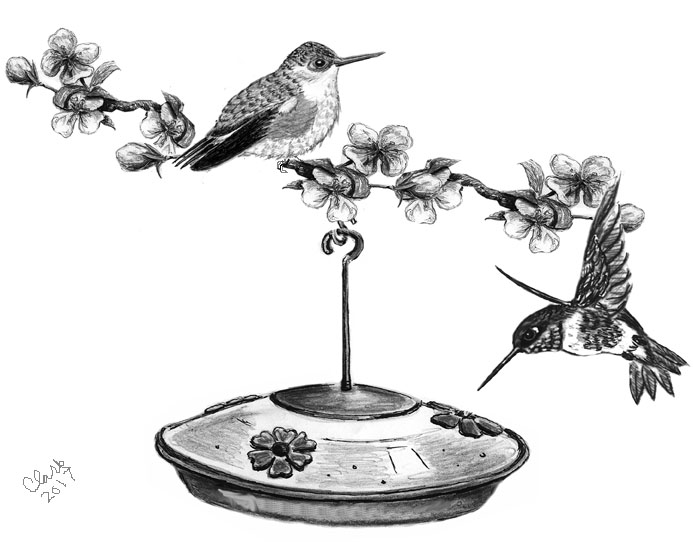
Dear Bird Folks,
I took this photo of a little hummingbird that was sitting in a tree outside our window. The feeder is just below the bird, but he/she never goes to it. When another hummingbird comes by, this bird “squeaks” and flies toward it, but the begging bird is always ignored. Is this a baby?
– George and Cindy, Mashnee Island
Okay, George and Cindy,
I’ll answer your question, but I have to do something else first. I have to tell everyone on the Lower Cape where the heck Mashnee Island is. For all we know it could be an island off the coast of Maine, a resort in the Caribbean or the name of a tanning salon in Mashpee Commons. Mashnee Island is situated in Buzzards Bay, at the west end of the Cape Cod Canal. It’s also not an island, but it used to be. Mashnee Island stopped being an island when the Canal was enlarged in the 1930s. It seems the engineers needed someplace to pile the extra dirt, so they decided to create a mile-long causeway to connect Mashnee Island to the rest of Cape Cod. Although exactly which part of the Cape the causeway is connected to isn’t clear, at least not to me. From the looks of things, the causeway begins near an obscure community called “Gray Gables Village.” Gray Gables Village? It sounds like a rest home.
Identifying young hummingbirds can be a little tricky (although, not as tricky as understanding that Gray Gables thing). Basically, newly fledged hummingbirds look like females. They are light on the front and green on the back. If you look closely, however, you can sometimes see tiny gray patches of feathers on the wings. The problem is, hummers zip about like shooting stars, and thus these patches are nearly impossible to see. Fortunately, you have supplied me with an excellent photo. After studying it, I can confirm that you indeed have a brand new 2017 baby hummingbird in your yard. But why is the baby’s begging being ignored? Shouldn’t the mother be feeding it? Nope. She’s done enough for her kids this year and now it’s time for her to enjoy some “mom” time. I’ll explain.
It’s hard to imagine a bird that works harder than a female hummingbird. Each spring, female hummers, which barely weigh a tenth of an ounce, make the long, arduous trip north from Central America. Along the way, they have to deal with storms, predators and other hummingbirds wanting to fight them at every food source. If they somehow survive the journey and make it to the breeding grounds (which, in this case, is Mashnee Island), they will immediately get down to business. There is no time to get reacquainted with old neighbors, shop for new curtains or check email. Each female is too busy attacking any hummingbird that dares to enter her territory. And in between battles, she has to find time to build her nest. Most songbird couples assist each other with territorial defense, nest construction and other domestic chores, but female hummers do it all by themselves. She gets zero help from the man in her life. Actually, he’s another problem she has to deal with. He is so fired up about defending his own territory that he will even attack potential mates. Eventually, she gets him to calm down, at least long enough to mate, and then sends him on his way. She has no more use for him. (The poor males must feel so cheap.)
After laying two tiny eggs, the female will spend the next few weeks sitting all alone on the nest. When the eggs finally hatch, her stress-filled life becomes even harder. With no mate to bring food to either her or her chicks, this single mom must find a way to gather food, while still managing to keep her featherless babies warm. The hatchlings regularly receive a mixture of nectar and slightly digested insects, which their mother shoves down their throats with her spear-like beak. The little birds are blind at this point and it’s probably a good thing. Can you imagine if the first thing they see in life is a spear-like beak coming at them? That’s enough to give any kid an eating disorder. Eventually, the young hummers grow feathers and now mom has more time to find food. But that doesn’t mean she can relax. The growing chicks are hungrier than ever. To satisfy them, the mother hunts for all sorts of tiny bugs, including insect eggs and aphids. (Keep that in mind the next time you are thinking about spraying your rose bushes.)
By the eighteenth day the kids are bored and now spend their time on the edge of the nest, exercising their wings. Now it’s only a matter of time before they feel strong and brave enough to go for their first solo flight. For the first few days after the fledglings leave the nest their mother keeps a close eye on them; after that they are on their own. It’s been a long breeding season and she has had enough. Her offspring, which actually weigh twice as much as she does, are now able to fly, hunt and feed themselves…and she wants nothing more to do with them. Even if her fledglings continue to beg, they’ll be ignored. And if they get in her way at the feeder, they’ll get whacked. She so isn’t in the mood to deal with any more kids. Yup, I can identify with that.
It might take a day or two, George and Cindy, but your young hummer will eventually figure things out and start feeding on its own. As for the mother, she has worked very hard and now needs to take a nice long rest. Hey, maybe she should book a room in Gray Gables Village.